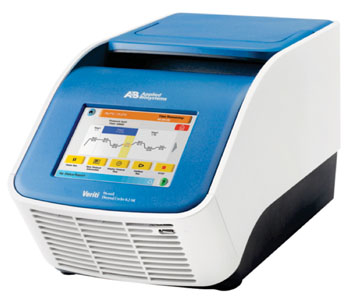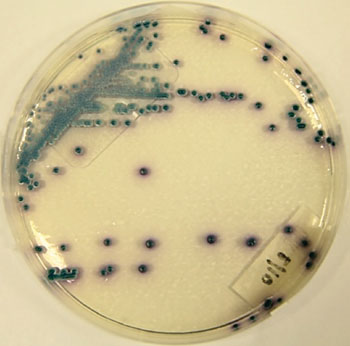Multiplex Nested PCR Detects Bloodstream Candida Species
|
By LabMedica International staff writers Posted on 14 Aug 2014 |

Image: The Veriti 96-Well Thermal Cycler for polymerase chain reactions (PCR) (Photo courtesy of Applied Biosystems).

Image: Candida tropicalis growing on specific CHROMagar culture media (Photo courtesy of Takamasa Kaneko).
A multiplex nested polymerase chain reaction (PCR) method has been developed to detect and identify seven Candida species in peripheral blood samples of critically ill pediatric patients.
Nosocomial candidaemia is associated with high mortality rates in critically ill pediatric and neonatal patients and therefore the early detection and identification of the infectious fungal agent is crucial for successful medical intervention.
Clinical microbiologists at the University of Sao Paulo (Butanta, Brazil) enrolled 54 consecutive pediatric patients, among whom there were 24 neonates, admitted to the intensive care unit (ICU) of two pediatric referral hospitals in Sao Paulo State (Brazil). The patients presented with systemic inflammatory response syndrome (SIRS) and at least two predisposing conditions/risk factors for the development of candidaemia. A control group included 28 children that had no evidence of any type of bloodstream infection and had undergone minor surgical procedures during the same time.
Blood samples were taken and either cultured or had DNA extracted. The 54 DNA samples were evaluated by multiplex nested PCR with specific primers designed to identify seven Candida species, and the results were compared with those obtained from blood cultures.
The extracted DNA samples were amplified and the reactions were carried out in a Veriti thermocycler (Applied Biosystems; Carlsbad, CA, USA). The nested PCR products were detected on 2.5% agarose gels and visualized under a UV transilluminator apparatus (UVITEC; Cambridge, UK).
The multiplex nested PCR had a detection limit of four Candida genomes/mL of blood for all Candida species. Blood cultures were positive in 14.8% of patients, whereas the multiplex nested PCR was positive in 24.0% of patients, including all culture-positive patients. The results obtained with the molecular technique were available within 24 hours, and the assay was able to identify Candida species with 100% of concordance with blood cultures. Additionally the multiplex nested PCR detected dual candidaemia in three patients. Candida albicans was the most frequently isolated species in blood cultures (five out of eight positive results), while the multiplex nested PCR identified C. albicans, C. parapsilosis complex, and C. tropicalis at similar frequencies.
The authors concluded that multiplex PCR assay targeting the intergenic space region (ITS) of Candida ribosomal DNA was able to identify the main Candida species involved in bloodstream pediatric infections with a detection limit of less than 10 colony forming units (CFU)/mL. The assay had high specificity, and is as least as sensitive as blood cultures but with a shorter turnaround time. The use of the multiplex nested PCR method also allowed the detection and identification of one or more Candida species in the same reaction. The study was published on July 21, 2014, in the journal BMC Infectious Diseases.
Related Links:
University of Sao Paulo
Applied Biosystems
UVITEC
Nosocomial candidaemia is associated with high mortality rates in critically ill pediatric and neonatal patients and therefore the early detection and identification of the infectious fungal agent is crucial for successful medical intervention.
Clinical microbiologists at the University of Sao Paulo (Butanta, Brazil) enrolled 54 consecutive pediatric patients, among whom there were 24 neonates, admitted to the intensive care unit (ICU) of two pediatric referral hospitals in Sao Paulo State (Brazil). The patients presented with systemic inflammatory response syndrome (SIRS) and at least two predisposing conditions/risk factors for the development of candidaemia. A control group included 28 children that had no evidence of any type of bloodstream infection and had undergone minor surgical procedures during the same time.
Blood samples were taken and either cultured or had DNA extracted. The 54 DNA samples were evaluated by multiplex nested PCR with specific primers designed to identify seven Candida species, and the results were compared with those obtained from blood cultures.
The extracted DNA samples were amplified and the reactions were carried out in a Veriti thermocycler (Applied Biosystems; Carlsbad, CA, USA). The nested PCR products were detected on 2.5% agarose gels and visualized under a UV transilluminator apparatus (UVITEC; Cambridge, UK).
The multiplex nested PCR had a detection limit of four Candida genomes/mL of blood for all Candida species. Blood cultures were positive in 14.8% of patients, whereas the multiplex nested PCR was positive in 24.0% of patients, including all culture-positive patients. The results obtained with the molecular technique were available within 24 hours, and the assay was able to identify Candida species with 100% of concordance with blood cultures. Additionally the multiplex nested PCR detected dual candidaemia in three patients. Candida albicans was the most frequently isolated species in blood cultures (five out of eight positive results), while the multiplex nested PCR identified C. albicans, C. parapsilosis complex, and C. tropicalis at similar frequencies.
The authors concluded that multiplex PCR assay targeting the intergenic space region (ITS) of Candida ribosomal DNA was able to identify the main Candida species involved in bloodstream pediatric infections with a detection limit of less than 10 colony forming units (CFU)/mL. The assay had high specificity, and is as least as sensitive as blood cultures but with a shorter turnaround time. The use of the multiplex nested PCR method also allowed the detection and identification of one or more Candida species in the same reaction. The study was published on July 21, 2014, in the journal BMC Infectious Diseases.
Related Links:
University of Sao Paulo
Applied Biosystems
UVITEC
Latest Microbiology News
- Breakthrough Diagnostic Technology Identifies Bacterial Infections with Almost 100% Accuracy within Three Hours
- Innovative ID/AST System to Help Diagnose Infectious Diseases and Combat AMR
- Gastrointestinal Panel Delivers Rapid Detection of Five Common Bacterial Pathogens for Outpatient Use
- Rapid PCR Testing in ICU Improves Antibiotic Stewardship
- Unique Genetic Signature Predicts Drug Resistance in Bacteria
- Unique Barcoding System Tracks Pneumonia-Causing Bacteria as They Infect Blood Stream
- Rapid Sepsis Diagnostic Test Demonstrates Improved Patient Care and Cost Savings in Hospital Application
- Rapid Diagnostic System to Detect Neonatal Sepsis Within Hours
- Novel Test to Diagnose Bacterial Pneumonia Directly from Whole Blood
- Interferon-γ Release Assay Effective in Patients with COPD Complicated with Pulmonary Tuberculosis
- New Point of Care Tests to Help Reduce Overuse of Antibiotics
- 30-Minute Sepsis Test Differentiates Bacterial Infections, Viral Infections, and Noninfectious Disease
- CRISPR-TB Blood Test to Enable Early Disease Diagnosis and Public Screening
- Syndromic Panel Provides Fast Answers for Outpatient Diagnosis of Gastrointestinal Conditions
- Culture-Free Platform Rapidly Identifies Blood Stream Infections
- POC PCR Test Rapidly Detects Bacterial Meningitis Directly at Point of Sample Collection
Channels
Clinical Chemistry
view channel
Carbon Nanotubes Help Build Highly Accurate Sensors for Continuous Health Monitoring
Current sensors can measure various health indicators, such as blood glucose levels, in the body. However, there is a need to develop more accurate and sensitive sensor materials that can detect lower... Read more
Paper-Based Device Boosts HIV Test Accuracy from Dried Blood Samples
In regions where access to clinics for routine blood tests presents financial and logistical obstacles, HIV patients are increasingly able to collect and send a drop of blood using paper-based devices... Read moreMolecular Diagnostics
view channel
D-Dimer Testing Can Identify Patients at Higher Risk of Pulmonary Embolism
Pulmonary embolism (PE) is a commonly suspected condition in emergency departments (EDs) and can be life-threatening if not diagnosed correctly. Achieving an accurate diagnosis is vital for providing effective... Read more
New Biomarkers to Improve Early Detection and Monitoring of Kidney Injury
Drug-induced kidney injury, also known as nephrotoxicity, is a prevalent issue in clinical practice, occurring when specific medications at certain doses cause damage to the kidneys. Nephrotoxicity can... Read moreHematology
view channel
New Scoring System Predicts Risk of Developing Cancer from Common Blood Disorder
Clonal cytopenia of undetermined significance (CCUS) is a blood disorder commonly found in older adults, characterized by mutations in blood cells and a low blood count, but without any obvious cause or... Read more
Non-Invasive Prenatal Test for Fetal RhD Status Demonstrates 100% Accuracy
In the United States, approximately 15% of pregnant individuals are RhD-negative. However, in about 40% of these cases, the fetus is also RhD-negative, making the administration of RhoGAM unnecessary.... Read moreImmunology
view channel
Post-Treatment Blood Test Could Inform Future Cancer Therapy Decisions
In the ongoing advancement of personalized medicine, a new study has provided evidence supporting the use of a tool that detects cancer-derived molecules in the blood of lung cancer patients years after... Read more
Cerebrospinal Fluid Test Predicts Dangerous Side Effect of Cancer Treatment
In recent years, cancer immunotherapy has emerged as a promising approach where the patient's immune system is harnessed to fight cancer. One form of immunotherapy, called CAR-T-cell therapy, involves... Read more
New Test Measures Preterm Infant Immunity Using Only Two Drops of Blood
Preterm infants are particularly vulnerable due to their organs still undergoing development, which can lead to difficulties in breathing, eating, and regulating body temperature. This is especially true... Read more
Simple Blood Test Could Help Choose Better Treatments for Patients with Recurrent Endometrial Cancer
Endometrial cancer, which develops in the lining of the uterus, is the most prevalent gynecologic cancer in the United States, affecting over 66,000 women annually. Projections indicate that in 2025, around... Read morePathology
view channel
AI Model Predicts Patient Response to Bladder Cancer Treatment
Each year in the United States, around 81,000 new cases of bladder cancer are diagnosed, leading to approximately 17,000 deaths annually. Muscle-invasive bladder cancer (MIBC) is a severe form of bladder... Read more
New Laser-Based Method to Accelerate Cancer Diagnosis
Researchers have developed a method to improve cancer diagnostics and other diseases. Collagen, a key structural protein, plays various roles in cell activity. A novel multidisciplinary study published... Read more
New AI Model Predicts Gene Variants’ Effects on Specific Diseases
In recent years, artificial intelligence (AI) has greatly enhanced our ability to identify a vast number of genetic variants in increasingly larger populations. However, up to half of these variants are... Read more
Powerful AI Tool Diagnoses Coeliac Disease from Biopsy Images with Over 97% Accuracy
Coeliac disease is an autoimmune disorder triggered by the consumption of gluten, causing symptoms such as stomach cramps, diarrhea, skin rashes, weight loss, fatigue, and anemia. Due to the wide variation... Read moreTechnology
view channel
Smartphones Could Diagnose Diseases Using Infrared Scans
Rapid advancements in technology may soon make it possible for individuals to bypass invasive medical procedures by simply uploading a screenshot of their lab results from their phone directly to their doctor.... Read more
Novel Sensor Technology to Enable Early Diagnoses of Metabolic and Cardiovascular Disorders
Metabolites are critical compounds that fuel life's essential functions, playing a key role in producing energy, regulating cellular activities, and maintaining the balance of bodily systems.... Read more
3D Printing Breakthrough Enables Large Scale Development of Tiny Microfluidic Devices
Microfluidic devices are diagnostic systems capable of analyzing small volumes of materials with precision and speed. These devices are used in a variety of applications, including cancer cell analysis,... Read moreIndustry
view channel




















